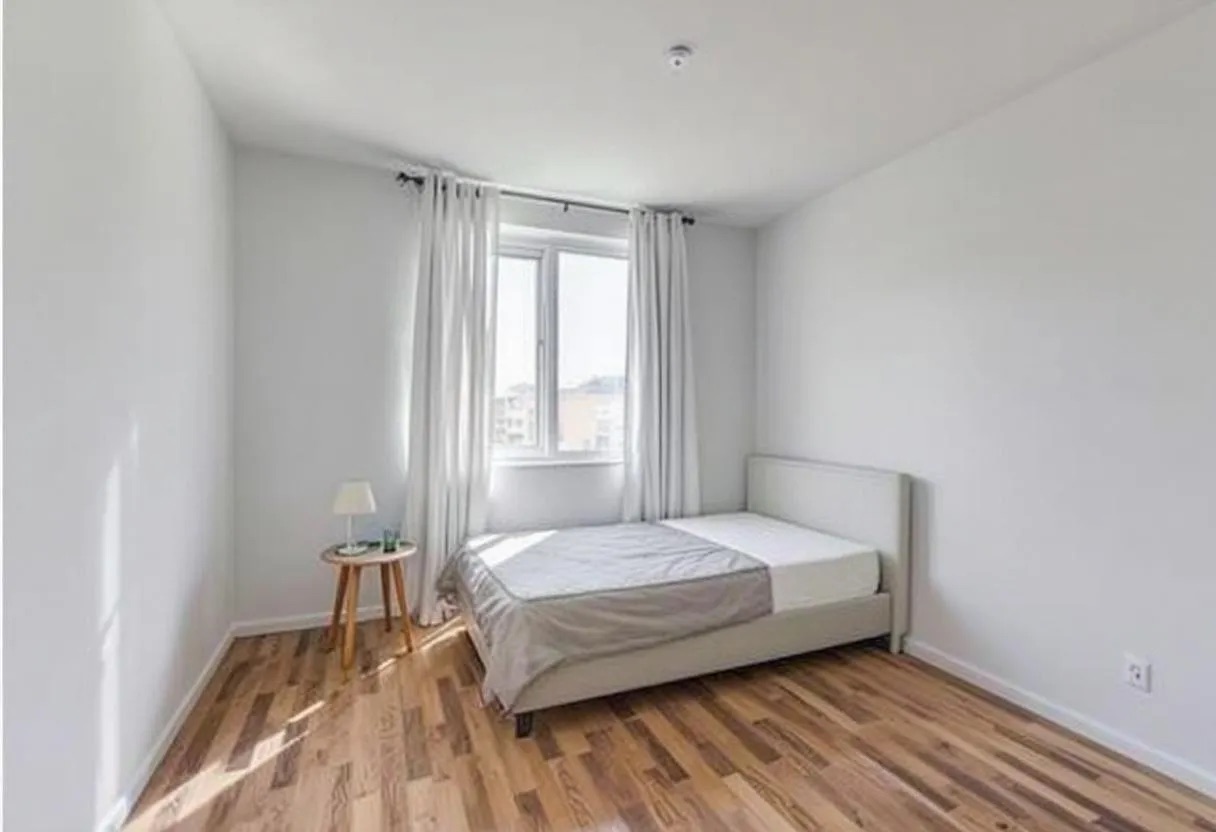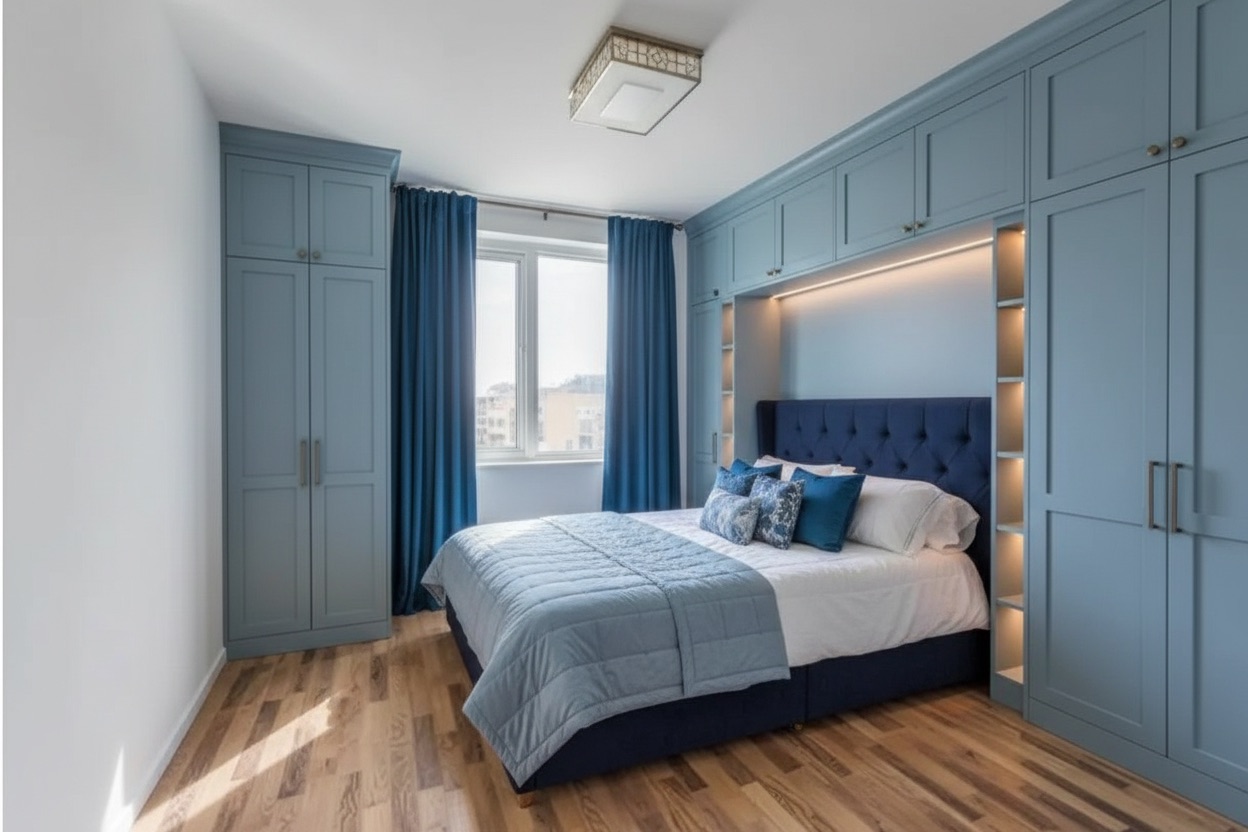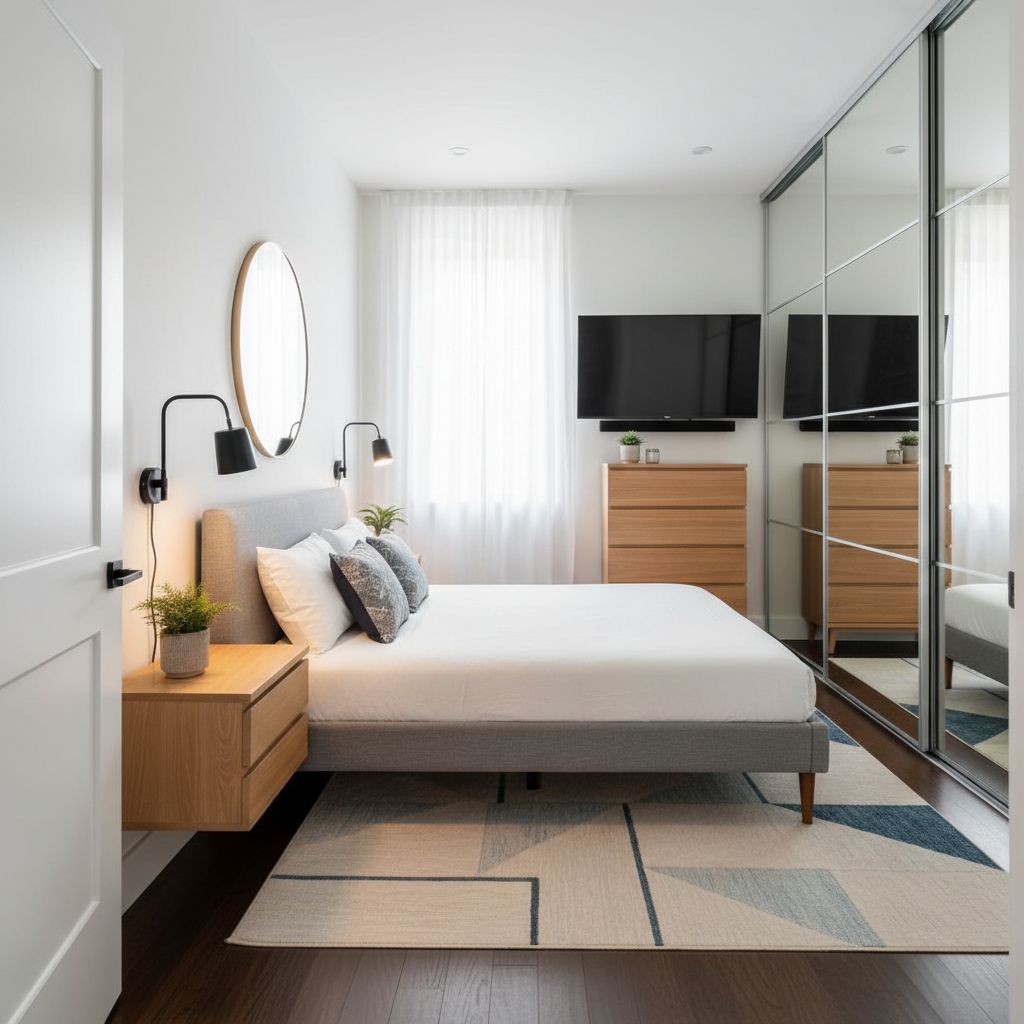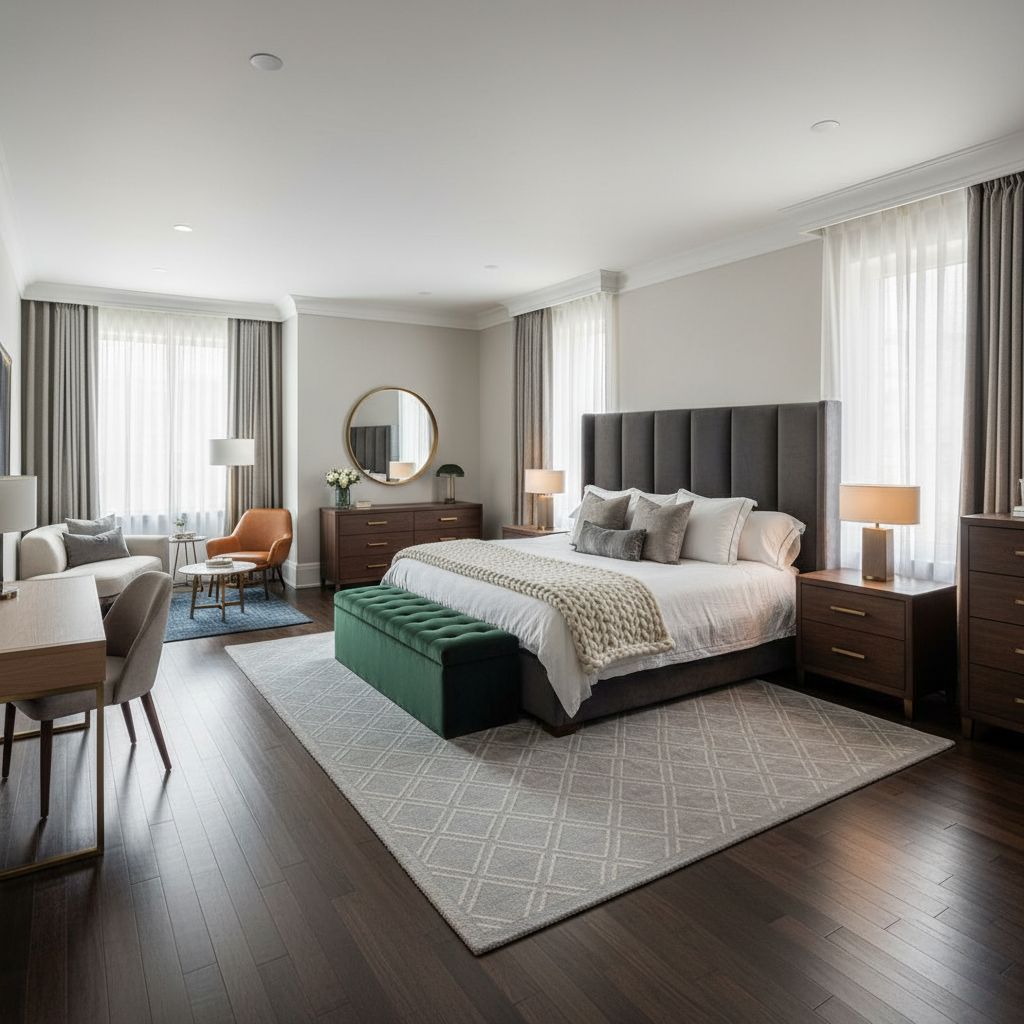Design Your DreamBedroom in30 Seconds
Upload a photo of your bedroom and get instant design ideas with personalized color schemes, furniture layouts, and style recommendations. See exactly how your space can look before making any purchases.


Bedroom Design Ideas by Style
Explore 6 popular bedroom styles with furniture guides, color palettes, and budget breakdowns

Modern Bedroom

Scandinavian Bedroom

Bohemian Bedroom

Minimalist Bedroom

Industrial Bedroom

Traditional Bedroom
Modern Bedroom
Clean lines, neutral colors, and functional furniture create a calming, uncluttered space perfect for rest.
🎨 Color Palette
🛋️ Key Furniture
- ✓Platform bed with clean lines
- ✓Floating nightstands
- ✓Minimal dresser with hidden storage
- ✓Geometric lighting fixtures
💰 Budget Ranges
Use the 60-30-10 rule: 60% neutral walls, 30% furniture color, 10% accent pillows


Best Bedroom Color Schemes
Proven color combinations with exact paint colors, lighting recommendations, and mood guides
Serene Blue
Calming blues with warm accents promote relaxation and deeper sleep
Warm Neutrals
Earthy tones create a cozy, grounded atmosphere
Sage Green
Natural greens bring outdoors in, reducing anxiety
Soft Gray
Sophisticated neutrals work with any decor style
Dusty Rose
Gentle pinks create warmth without being childish
Charcoal & White
Bold contrast creates drama while staying restful
Bedroom Layout Ideas by Room Size
Optimized furniture arrangements with clearances, measurements, and traffic flow guides

Small (10x10 ft)
Furniture Placement:
- ✓Full or Queen bed against longest wall
- ✓Two wall-mounted floating nightstands
- ✓Vertical storage (tall dresser)
- ✓Wall-mounted reading lights
Clearance Requirements:
Pro Tips:
- • Use mirrors to visually double the space
- • Choose furniture with legs to create visual space underneath
- • Mount TV on wall instead of using dresser space

Medium (12x14 ft)
Furniture Placement:
- ✓Queen or King bed centered on main wall
- ✓Two matching nightstands
- ✓Dresser opposite bed
- ✓Optional reading chair in corner
Clearance Requirements:
Pro Tips:
- • Center bed on focal wall for symmetry
- • Create conversation area with two chairs and small table
- • Use area rug to define sleeping zone

Large (14x16 ft)
Furniture Placement:
- ✓King bed with statement headboard
- ✓Two substantial nightstands
- ✓Dresser and separate chest
- ✓Seating area with two chairs
- ✓Bench at foot of bed
Clearance Requirements:
Pro Tips:
- • Create distinct zones (sleeping, dressing, sitting)
- • Use lighting to define each zone
- • Add architectural interest with accent wall

Master Suite (16x20 ft)
Furniture Placement:
- ✓King bed as focal point
- ✓Large nightstands with storage
- ✓Dresser and tall chest
- ✓Sitting area with loveseat or two chairs
- ✓Writing desk or vanity
- ✓Storage bench
Clearance Requirements:
Pro Tips:
- • Create hotel-suite feel with defined zones
- • Use rugs to anchor each area
- • Install dimmer switches for ambiance
Bedroom Makeover Budget Guides
Complete budget breakdowns with real prices, priorities, and timelines
Budget Refresh ($300-800)
High-impact changes without major purchases
Mid-Range Makeover ($1,500-4,000)
Includes some new furniture and quality improvements
Premium Transformation ($5,000-12,000)
High-end furniture and custom treatments
How to Design a Bedroom: Step-by-Step Guide
Follow this proven process used by professional interior designers
Measure Your Space
Measure room dimensions, ceiling height, window locations, and door swing. Note electrical outlets and any architectural features. Create a simple floor plan on graph paper (1 square = 1 foot).
Define Your Style
Browse bedroom ideas and save images you love. Look for patterns in your favorites - are they mostly modern, traditional, colorful, neutral? Take our style quiz below to identify your preferences.
Choose Your Color Scheme
Select 2-3 main colors from our color schemes above. Test paint samples on your wall and observe them in morning, afternoon, and evening light before committing. Remember: walls are 60%, furniture is 30%, accents are 10%.
Plan Your Layout
Position your bed first (focal point), then add nightstands, dresser, and other furniture. Ensure 24-30 inches of walking space around the bed. Check door and drawer clearances.
Select Furniture
Start with the bed and mattress (highest priority), then nightstands, dresser, and lighting. Measure doorways and stairwells before buying large pieces. Consider scale - small rooms need smaller furniture.
Layer Lighting
Install ambient lighting (ceiling fixture with dimmer), task lighting (reading lamps), and accent lighting (decorative). Use warm bulbs (2700K) for relaxation. Aim for 3-5 light sources total.
Add Textiles & Accessories
Layer bedding (sheet set, duvet, throw pillows, blanket), add curtains or blinds, place area rug, and hang artwork. This is 40% of your bedroom's visual impact - don't skip it!
Find Your Perfect Bedroom Style
Take our 2-minute style quiz to discover which bedroom design matches your personality
What's your ideal morning in your bedroom?
Real Bedroom Transformations
See how real people transformed their bedrooms using these guides
"I used the color palette guide and went with Soft Gray throughout. The before/after is incredible - my bedroom finally feels like a peaceful retreat instead of an afterthought."
"The layout templates helped me rearrange my 12x14 bedroom to fit a small workspace without making it feel cramped. Game changer for work-from-home life."
"Small bedroom, smaller budget. The budget guide showed me exactly where to spend money for maximum impact. I did the whole thing for under $600 and it looks amazing."
Bedroom Design Questions Answered
Expert answers to the most common bedroom design questions
How do I choose the right bedroom color?
Start with the mood you want: blues and greens promote calmness, warm neutrals create coziness, and grays offer versatility. Consider your room's natural light - north-facing rooms benefit from warm tones, while south-facing rooms can handle cooler colors. Test paint samples on your wall and observe them at different times of day before committing. Most designers recommend starting with neutral walls (60% of the room) and adding color through bedding and accessories (30-10%).
What size bed should I get for my bedroom?
Leave at least 24-30 inches of walking space on each side of the bed. For a 10x10 room, a full or queen works best. For 12x14, a queen or king fits comfortably. For 14x16 or larger, a king bed won't overwhelm the space. Measure your room, subtract the clearances (24 inches on each side, 36 inches at the foot), and you'll know your maximum bed size. Remember: bigger isn't always better if it makes the room feel cramped.
How can I make a small bedroom look bigger?
Use light colors on walls (they reflect light and recede visually), hang mirrors to double visual space, choose furniture with legs (creates airiness underneath), use vertical storage instead of bulky dressers, and avoid dark, heavy curtains. Stick to a simple color palette (2-3 colors maximum) and use multi-functional furniture like storage beds. A single large piece of art looks better than many small pieces in small spaces.
What bedroom furniture do I actually need?
Essential: bed frame, mattress, two nightstands (or one if space is tight), and basic storage (dresser or closet organizer). Nice to have: reading chair, full-length mirror, bench at foot of bed, and task lighting. Skip: oversized furniture that blocks walkways, matching furniture sets (mix pieces for character), and too many decorative items. Start with essentials, live in the space, then add pieces as you identify needs.
How much should I spend on bedroom furniture?
Prioritize your mattress (you spend 1/3 of your life in bed) - budget $600-2,000 for quality. For other furniture, expect $1,500-4,000 for a complete bedroom (bed frame, nightstands, dresser) at mid-range quality. Budget-friendly: $800-1,500. Premium: $5,000-12,000. Buy the best mattress you can afford, then allocate remaining budget to furniture. Consider buying one quality piece at a time rather than a cheap matching set.
What is the best bedroom layout?
Center your bed on the longest wall or wall across from the door (this creates a focal point when entering). Place nightstands on both sides if space allows. Position the dresser where you can see yourself in the mirror while standing (usually opposite the bed). Ensure 24-30 inches of walking space around the bed. Avoid blocking windows, placing the bed directly under a window (drafty), or blocking the natural traffic flow from door to closet.
How do I design a bedroom on a tight budget?
Start with paint ($80-120 for dramatic impact), invest in quality bedding ($150-250 makes a huge difference), and rearrange existing furniture before buying new pieces (free!). Shop secondhand for dressers and nightstands (refinish if needed), use removable wallpaper for accent walls ($50-80), and DIY art from fabric or prints. Focus on the bed - it's 60% of your bedroom's visual impact. See our Budget Refresh guide for a complete $500-800 makeover plan.
What lighting is best for bedrooms?
Layer three types: ambient (ceiling fixture on dimmer), task (reading lamps on nightstands), and accent (decorative string lights or picture lights). Use warm white bulbs (2700K) for relaxation, avoid blue-toned lights before bed. Install dimmer switches (easy DIY, $15-30 per switch). Aim for 40-50 lumens per square foot for ambient light, 300-400 lumens for reading lamps. Consider smart bulbs that dim automatically in the evening.
Ready to Design Your Dream Bedroom?
Upload your bedroom photo and get personalized design recommendations in minutes.
